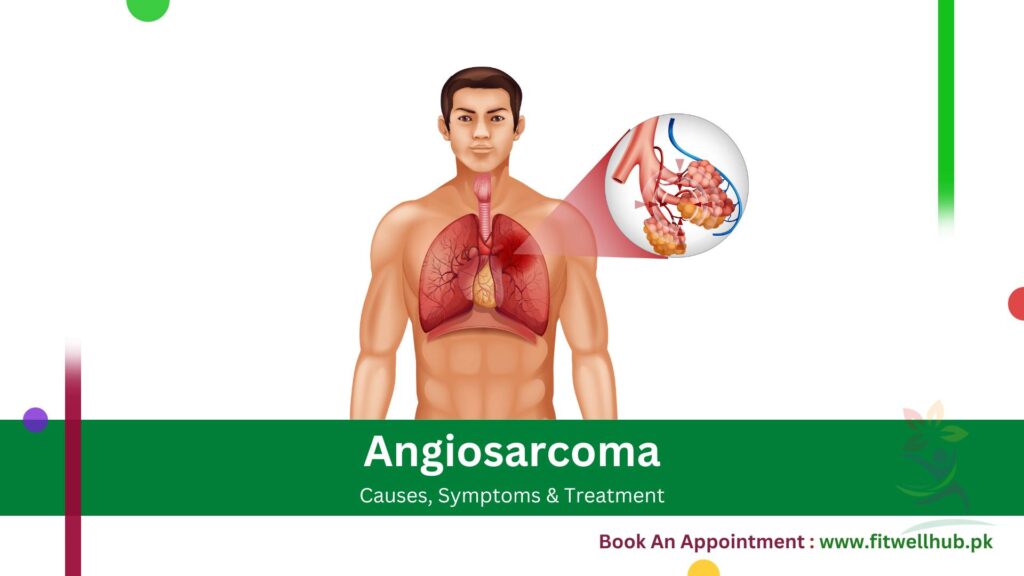Angiosarcoma is a rare type of cancer that originates in the lining of blood vessels and lymph vessels. Although it may be from anywhere in the body, it is most commonly found in the skin, breast, liver, and deep tissues.
Quick Links
ToggleAngiosarcoma is an aggressive type of cancer, and therefore it spreads rapidly to other parts of the body. Early detection and treatment are essential for improving results. Having a complete understanding of the symptoms, causes, and risk factors associated with angiosarcoma is crucial for managing this condition effectively.
Symptoms
Some of the commonly experienced symptoms of angiosarcoma are as follows:
- Skin Lesions: Angiosarcoma of the skin normally manifests as lesions, which are red or purple and can give the appearance of bruising. The lesions may bleed or ulcerate, hence leading to other complications.
- Swelling: The sudden development of swelling in the affected area is very common, particularly when the tumor affects deeper tissue or organs. This swelling leads to discomfort and limitation of movement.
- Pain: Pain is a symptom commonly felt in the region involved, particularly about tumor growth and the weight exerted by the tumor on the surrounding tissues. The pain is often continuous and may worsen over time.
- Fatigue: A feeling of weakness or generalized fatigue is also commonly seen as the disease advances. This results from the body’s reaction to cancer and because of the nutritional demand by the tumor.
- Weight Loss: It also causes sudden weight loss, because the body has a hard time keeping up with energy levels while trying to handle the metabolic demands of the growing cancer.
When to See a Doctor
If you are experiencing symptoms such as skin lesions, swelling, or pain, you should consult with a doctor. Due to its aggressive nature, angiosarcoma requires an early diagnosis and timely management to prevent the further spread of the tumor. If symptom severity increases or new symptoms appear, it requires medical attention. At Fitwell Hub, our experienced doctors are ready to provide you with comprehensive care and guide you through the necessary treatments.
Ready to take the first step toward a healthier, happier you? Book an appointment with us today, and let our experts guide you on your wellness journey!
Causes
The exact cause of angiosarcoma is not clear, but several risk factors have been identified:
1- Radiation Therapy
Radiation therapy previously used for cancer treatment increases the risk of developing tumors. The risk of developing tumors increases over time, especially in affected areas that are treated with radiation.
2- Chronic Lymphedema
Accumulation of lymph fluid causes long-term swelling. It occurs due to lymph node removal or damage. It increases the risk of angiosarcoma developing in the affected area.
3- Chemical Exposure
In industrial areas, persistent exposure to certain chemicals, like arsenic or vinyl chloride, increases the risk of developing angiosarcoma.
4- Genetic Factors
Having a family history of genetic disorders, such as neurofibromatosis, increases the risk of developing angiosarcoma. It commonly occurs in individuals with a genetic susceptibility to cancer.
5- Immune System Suppression
Medications, chronic illnesses, or infections weaken an immune system. Weakened immune systems are more susceptible to developing angiosarcoma.
Risk Factors
Primary risk factors associated with angiosarcoma are:
- Age: Older age people, generally those over 50 years of age, are at greater risk of developing cancer. Due to increased age, the immune system also weakens, and the risk increases.
- Gender: Men are slightly more susceptible to developing angiosarcoma than women. However, the reasons for this gender difference are not fully clear.
Complications
Angiosarcoma can cause serious complications if left untreated:
1- Metastasis: Angiosarcoma rapidly spreads (metastasizes) to other parts of the body, such as the lungs, liver, or bones. It makes treatment more complex and the diagnosis worse.
2- Recurrence: Despite initial treatment and medication, angiosarcoma has a high chance of recurrence. It requires prolonged monitoring and additional treatments.
3- Organ Dysfunction: Tumors disrupt the function of affected organs. It causes further health complications, particularly if the cancer spreads to vital organs like the liver or lungs.
Prevention
Preventing angiosarcoma is challenging due to its rare and aggressive nature, but certain measures can reduce the risk:
- Limit Radiation Exposure: Minimizing exposure to unnecessary radiation, particularly during medical treatments, can help reduce the risk of developing angiosarcoma in the future.
- Monitor Lymphedema: Chronic lymphedema should be monitored closely, as prolonged swelling can increase the risk of angiosarcoma. Proper management of lymphedema can help reduce this risk.
- Avoid Chemical Exposure: Limiting exposure to harmful chemicals, especially in industrial settings, can lower the risk of developing angiosarcoma. Using protective equipment and following safety guidelines is crucial.
- Regular Health Check-ups: Regular medical check-ups, especially for those with known risk factors, can help in the early detection of angiosarcoma, improving the chances of successful treatment.
At Fitwell Hub, we offer a Healthy Elite Lifestyle Program designed to help you manage and reduce the risk of various health conditions. Visit our help page to learn more about our programs and services.
Diagnosis
For the diagnosis and confirmation of angiosarcoma, a combination of tests is used. These tests are:
- Imaging Studies: Usually, imaging studies such as MRI, CT, and PET scans are performed to evaluate the tumor site and size, as well as other sites of spread in the body.
- Biopsy: A biopsy is a surgical procedure in which a sample of tissue is taken from the tumor to examine it under a microscope. It is one sure method of checking the presence of angiosarcoma and its type.
- Blood Tests: Blood tests help to identify the presence of markers that signal the presence of cancer. They are also used in the general health checkup that helps doctors reach a diagnosis.
- Genetic Testing: This is done when there is suspicion that a hereditary condition may be playing a role in the development of angiosarcoma. It helps guide and facilitate treatment decisions.
- PET Scan: This is a test used to locate active cancer cells in the body. It helps in determining the extent of the disease, therefore guiding the treatment approach.
For comprehensive diagnostic services, Fitwell Hub offers a wide range of tests. Visit our lab for more information.
Treatment
Treatment options for angiosarcoma vary depending on the location and stage of the cancer. A few commonly used treatment options are discussed below:
- Surgery: Surgery is used as a first-line treatment. It removes the tumor and surrounding tissue. However, in some cases, additional therapies are required to remove cancerous cells completely.
- Radiation Therapy: In radiation therapy, high-energy rays are used to target and destroy cancer cells. Normally it is used after surgery to reduce the risk of recurrence of cancer or when surgery is not an option.
- Chemotherapy: In chemotherapy, drugs are used to kill cancer cells throughout the body. It is generally used when the cancer has spread or as an addition to other treatments.
- Targeted Therapy: In targeted therapy, drugs are used to specifically target cancer cells without affecting normal cells. It is a more effective treatment option with fewer side effects.
Medications
A few commonly used medications in the treatment of angiosarcoma are:
1- Chemotherapy Drugs
Angiosarcoma chemotherapy drugs include Doxorubicin, Paclitaxel, and Ifosfamide. These medicines kill rapidly dividing cells of cancer.
2- Targeted Therapy Drugs
Targeted therapy drugs include sorafenib or pazopanib. These drugs target specific molecular pathways involved in cancer growth and disease progression.
3- Immunotherapy
The purpose of immunotherapy is to enhance the general body’s immune system and enable the body’s mechanisms to fight cancer effectively.
4- Pain Management Medications
Pain management medications include opioids or nonsteroidal anti-inflammatory drugs, commonly known as NSAIDs. Pain management is crucial for improving the quality of life of angiosarcoma patients.
5- Anti-Nausea Medications
Anti-nausea medications are highly utilized in managing the side effects of chemotherapy. These medications make the treatment process quite tolerable for patients.
At Fitwell Hub, our pharmacy offers a range of medications for treating angiosarcoma and related symptoms. Visit our pharmacy to explore available options and consult with our experts.
Frequently Ask Questions (FAQ’s)
Early signs and symptoms of angiosarcoma include skin lesions, swelling, and continuous pain in the concerned area.
Angiosarcoma is diagnosed by imaging tests, biopsies, and blood tests to confirm cancer and evaluate its extent.
These include surgery, radiation therapy, chemotherapy, and targeted therapy, which are done based on the site and stage of the tumor.
While there are not many ways to prevent this particular kind of cancer, minimizing exposure to carcinogens like radiation and toxic chemicals can reduce risk.
The prognosis for angiosarcoma is very variable, depending not only on the stage of the disease at diagnosis but also, importantly, on the adequacy of treatment. Early detection provides the best outcomes.











